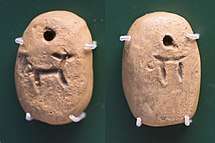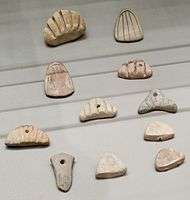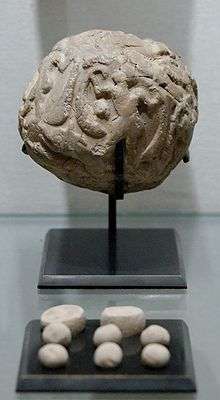History of writing
The history of writing traces the development of expressing language by letters or other marks[1] and also the studies and descriptions of these developments.
| Writing systems |
|---|
 |
| Types |
| Related topics |
| Part of a series on | |||
| Human history Human Era | |||
|---|---|---|---|
| ↑ Prehistory (Pleistocene epoch) | |||
| Holocene | |||
|
|
|||
| Ancient | |||
|
|
|||
| Postclassical | |||
|
|
|||
| Modern | |||
|
|||
| ↓ Future | |||
In the history of how writing systems have evolved in different human civilizations, more complete writing systems were preceded by proto-writing, systems of ideographic or early mnemonic symbols (symbols or letters that make remembering them easier). True writing, in which the content of a linguistic utterance is encoded so that another reader can reconstruct, with a fair degree of accuracy, the exact utterance written down, is a later development. It is distinguished from proto-writing, which typically avoids encoding grammatical words and affixes, making it more difficult or even impossible to reconstruct the exact meaning intended by the writer unless a great deal of context is already known in advance. One of the earliest forms of written expression is cuneiform.[2]
Inventions of writing
.svg.png)
Writing was long thought to have been invented in a single civilization, a theory named "monogenesis".[3] Scholars believed that all writing originated in ancient Sumer (in Mesopotamia) and spread over the world from there via a process of cultural diffusion.[3] According to this theory, the concept of representing language by written marks, though not necessarily the specifics of how such a system worked, was passed on by traders or merchants traveling between geographical regions.[4][5]
However, the discovery of the scripts of ancient Mesoamerica, far away from Middle Eastern sources, proved that writing could be invented independently. Scholars now recognize that writing may have independently developed in at least four ancient civilizations: Mesopotamia (between 3400 and 3100 BC), Egypt (around 3250 BC),[6][7][3] China (2000 BC),[8] and lowland Mesoamerica (by 650 BC).[9]
Regarding Egypt, several scholars[6][10][11] have argued that "the earliest solid evidence of Egyptian writing differs in structure and style from the Mesopotamian and must therefore have developed independently. The possibility of 'stimulus diffusion' from Mesopotamia remains, but the influence cannot have gone beyond the transmission of an idea."[6][12]
Regarding China, ancient Chinese characters are an independent invention because there is no evidence of contact between ancient China and the literate civilizations of the Near East,[13] and because of the distinct differences between the Mesopotamian and Chinese approaches to logography and phonetic representation.[14]
Debate surrounds the Indus script of the Bronze Age Indus Valley civilization, the Rongorongo script of Easter Island, and the Vinča symbols dated around 5,500 BCE. All are undeciphered, and so it is unknown if they represent authentic writing, proto-writing, or something else.
The Sumerian archaic (pre-cuneiform) writing and Egyptian hieroglyphs are generally considered the earliest true writing systems, both emerging out of their ancestral proto-literate symbol systems from 3400–3100 BC, with earliest coherent texts from about 2600 BC. The Proto-Elamite script is also dated to the same approximate period.[15]
Writing systems
Symbolic communication systems are distinguished from writing systems in that one must usually understand something of the associated spoken language to comprehend the text. In contrast, symbolic systems, such as information signs, painting, maps, and mathematics, often do not require prior knowledge of a spoken language. Every human community possesses language, a feature regarded by many as an innate and defining condition of humanity (see Origin of language). However the development of writing systems, and their partial supplantation of traditional oral systems of communication, have been sporadic, uneven, and slow. Once established, writing systems on the whole change more slowly than their spoken counterparts and often preserve features and expressions that no longer exist in the spoken language.
There are considered to be three writing criteria for all writing systems. The first being that writing must be complete. It must have a purpose or some sort of meaning to it. A point must be made or communicated in the text. Second, all writing systems must have some sort of symbols which can be made on some sort of surface, whether physical or digital. Lastly, the symbols used in the writing system must mimic spoken word/speech, in order for communication to be possible.[17]
The greatest benefit of writing is that it provides the tool by which society can record information consistently and in greater detail, something that could not be achieved as well previously by spoken word. Writing allows societies to transmit information and to share knowledge.
Recorded history
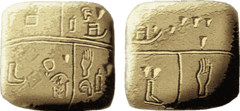
The origins of writing appear during the start at of the pottery-phase of the Neolithic, when clay tokens were used to record specific amounts of livestock or commodities.[18] These tokens were initially impressed on the surface of round clay envelopes and then stored in them.[18] The tokens were then progressively replaced by flat tablets, on which signs were recorded with a stylus. Actual writing is first recorded in Uruk, at the end of the 4th millennium BC, and soon after in various parts of the Near-East.[18]
An ancient Mesopotamian poem gives the first known story of the invention of writing:
Because the messenger's mouth was heavy and he couldn't repeat (the message), the Lord of Kulaba pattes some clay and put words on it, like a tablet. Until then, there had been no putting words on clay.
Scholars make a reasonable distinction between prehistory and history of early writing[21] but have disagreed concerning when prehistory becomes history and when proto-writing became "true writing." The definition is largely subjective.[22] Writing, in its most general terms, is a method of recording information and is composed of graphemes, which may, in turn, be composed of glyphs.[23]
The emergence of writing in a given area is usually followed by several centuries of fragmentary inscriptions. Historians mark the "historicity" of a culture by the presence of coherent texts in the culture's writing system(s).[21]
The invention of writing was not a one-time event but was a gradual process initiated by the appearance of symbols, possibly first for cultic purposes.
Developmental stages
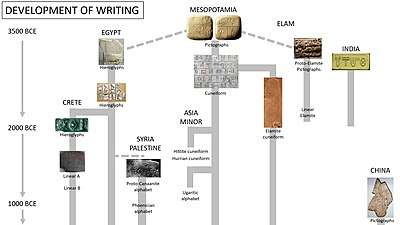
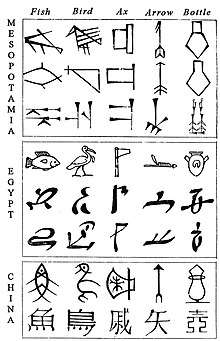
A conventional "proto-writing to true writing" system follows a general series of developmental stages:
- Picture writing system: glyphs (simplified pictures) directly represent objects and concepts. In connection with this, the following substages may be distinguished:
- Mnemonic: glyphs primarily as a reminder.
- Pictographic: glyphs directly represent an object or a concept such as (A) chronological, (B) notices, (C) communications, (D) totems, titles, and names, (E) religious, (F) customs, (G) historical, and (H) biographical.
- Ideographic: graphemes are abstract symbols that directly represent an idea or concept.
- Transitional system: graphemes refer not only to the object or idea that it represents but to its name as well.
- Phonetic system: graphemes refer to sounds or spoken symbols, and the form of the grapheme is not related to its meanings. This resolves itself into the following substages:
- Verbal: grapheme (logogram) represents a whole word.
- Syllabic: grapheme represents a syllable.
- Alphabetic: grapheme represents an elementary sound.
The best known picture writing system of ideographic or early mnemonic symbols are:
- Jiahu symbols, carved on tortoise shells in Jiahu, c. 6600 BC
- Vinča signs (Tărtăria tablets), c. 5300 BC[26]
- Early Indus script, c. 3100 BC
In the Old World, true writing systems developed from neolithic writing in the Early Bronze Age (4th millennium BC).
Literature and writing
The history of literature begins with the history of writing, but literature and writing, though obviously connected, are not synonymous. The very first writings from ancient Sumer by any reasonable definition do not constitute literature. The same is true of some of the early Egyptian hieroglyphics and the thousands of ancient Chinese government records. Scholars have disagreed concerning when written record-keeping became more like literature, but the oldest surviving literary texts date from a full millennium after the invention of writing. The earliest literary authors known by name are Ptahhotep (who wrote in Egyptian) and Enheduanna[27] (who wrote in Sumerian), dating to around the 24th and 23rd centuries BC, respectively.
Locations and timeframes
Proto-writing
The first writing systems of the Early Bronze Age were not a sudden invention. Rather, they were a development based on earlier traditions of symbol systems that cannot be classified as proper writing, but have many of the characteristics of writing. These systems may be described as "proto-writing." They used ideographic or early mnemonic symbols to convey information, but it probably directly contained no natural language. These systems emerged in the early Neolithic period, as early as the 7th millennium BC, and include:
- The Jiahu symbols found carved in tortoise shells in 24 Neolithic graves excavated at Jiahu, Henan province, northern China, with radiocarbon dates from the 7th millennium BC.[29] Most archaeologists consider these not directly linked to the earliest true writing.[30]
- Vinča symbols, sometimes called the "Danube script" - are a set of symbols found on Neolithic era (6th to 5th millennia BC) artifacts from the Vinča culture of Central Europe and Southeastern Europe.[31]
- The Dispilio Tablet of the late 6th millennium may also be an example of proto-writing.
- The Indus script, which from 2600 BCE to 1900 BCE was used for extremely short inscriptions.
Even after the Neolithic, several cultures went through an intermediate stage of proto-writing before they used proper writing. The "Slavic runes" from the 7th and 8th centuries AD, mentioned by a few medieval authors, may have been such a system. The quipu of the Incas (15th century AD), sometimes called "talking knots," may have been of a similar nature. Another example is the pictographs invented by Uyaquk before the development of the Yugtun syllabary for the Central Alaskan Yup'ik language in about 1900.
Bronze Age writing
Writing emerged in many different cultures in the Bronze Age. Examples are the cuneiform writing of the Sumerians, Egyptian hieroglyphs, Cretan hieroglyphs, Chinese logographs, Indus script, and the Olmec script of Mesoamerica. The Chinese script likely developed independently of the Middle Eastern scripts around 1600 BC. The pre-Columbian Mesoamerican writing systems (including Olmec and Maya scripts) are also generally believed to have had independent origins. It is thought that the first true alphabetic writing was developed around 2000 BC for Semitic workers in the Sinai by giving mostly Egyptian hieratic glyphs Semitic values (see History of the alphabet and Proto-Sinaitic alphabet). The Ge'ez writing system of Ethiopia is considered Semitic. It is likely to be of semi-independent origin, having roots in the Meroitic Sudanese ideogram system.[32] Most other alphabets in the world today either descended from this one innovation, many via the Phoenician alphabet, or were directly inspired by its design. In Italy, about 500 years passed from the early Old Italic alphabet to Plautus (750 to 250 BC), and in the case of the Germanic peoples, the corresponding time span is again similar, from the first Elder Futhark inscriptions to early texts like the Abrogans (c. AD 200 to 750).
Cuneiform script
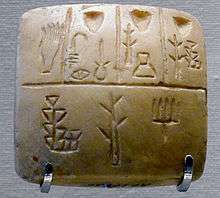
The original Sumerian writing system derives from a system of clay tokens used to represent commodities. By the end of the 4th millennium BC, this had evolved into a method of keeping accounts, using a round-shaped stylus impressed into soft clay at different angles for recording numbers. This was gradually augmented with pictographic writing by using a sharp stylus to indicate what was being counted. Round-stylus and sharp-stylus writing were gradually replaced around 2700–2500 BC by writing using a wedge-shaped stylus (hence the term cuneiform), at first only for logograms, but developed to include phonetic elements by the 29th century BC. About 2600 BC, cuneiform began to represent syllables of the Sumerian language. Finally, cuneiform writing became a general purpose writing system for logograms, syllables, and numbers. From the 26th century BC, this script was adapted to the Akkadian language, and from there to others, such as Hurrian and Hittite. Scripts similar in appearance to this writing system include those for Ugaritic and Old Persian.
Egyptian hieroglyphs
Writing was very important in maintaining the Egyptian empire, and literacy was concentrated among an educated elite of scribes. Only people from certain backgrounds were allowed to train as scribes, in the service of temple, royal (pharaonic), and military authorities.
Geoffrey Sampson stated that Egyptian hieroglyphs "came into existence a little after Sumerian script, and, probably [were], invented under the influence of the latter",[36] and that it is "probable that the general idea of expressing words of a language in writing was brought to Egypt from Sumerian Mesopotamia".[37][38] Despite the importance of early Egypt-Mesopotamia relations, given the lack of direct evidence "no definitive determination has been made as to the origin of hieroglyphics in ancient Egypt".[39] Instead, it is pointed out and held that "the evidence for such direct influence remains flimsy" and that "a very credible argument can also be made for the independent development of writing in Egypt..."[40] Since the 1990s, the discoveries of glyphs at Abydos, dated to between 3400 and 3200 BCE, may challenge the classical notion according to which the Mesopotamian symbol system predates the Egyptian one, although Egyptian writing does make a sudden appearance at that time, while on the contrary Mesopotamia has an evolutionary history of sign usage in tokens dating back to circa 8000 BCE.[34] These glyphs, found in tomb U-J at Abydos are written on ivory and are likely labels for other goods found in the grave.[41]
Elamite script
The undeciphered Proto-Elamite script emerges from as early as 3100 BC. It is believed to have evolved into Linear Elamite by the later 3rd millennium and then replaced by Elamite Cuneiform adopted from Akkadian.
Indus script

The Middle Bronze Age Indus script, which dates back to the early Harappan phase of around 3000 BCE in the Indian subcontinent corresponding to northwestern India and what is now Pakistan, has not yet been deciphered.[42] It is unclear whether it should be considered an example of proto-writing or whether it is actual writing of the logographic-syllabic type of the other Bronze Age writing systems. Mortimer Wheeler recognises the style of writing as boustrophedon, where "this stability suggests a precarious maturity."
Early Semitic alphabets
The first pure alphabets (properly, "abjads", mapping single symbols to single phonemes, but not necessarily each phoneme to a symbol) emerged around 1800 BC in Ancient Egypt, as a representation of language developed by Semitic workers in Egypt, but by then alphabetic principles had a slight possibility of being inculcated into Egyptian hieroglyphs for upwards of a millennium. These early abjads remained of marginal importance for several centuries, and it is only towards the end of the Bronze Age that the Proto-Sinaitic script splits into the Proto-Canaanite alphabet (c. 1400 BC) Byblos syllabary and the South Arabian alphabet (c. 1200 BC). The Proto-Canaanite was probably somehow influenced by the undeciphered Byblos syllabary and, in turn, inspired the Ugaritic alphabet (c. 1300 BC).
Anatolian hieroglyphs
Anatolian hieroglyphs are an indigenous hieroglyphic script native to western Anatolia, used to record the Hieroglyphic Luwian language. It first appeared on Luwian royal seals from the 14th century BC.
Chinese writing
The earliest confirmed evidence of the Chinese script yet discovered is the body of inscriptions on oracle bones and bronze from the late Shang dynasty. The earliest of these is dated to around 1200 BC.[43][44]
There have recently been discoveries of tortoise-shell carvings dating back to c. 6000 BC, like Jiahu Script, Banpo Script, but whether or not the carvings are complex enough to qualify as writing is under debate.[29] At Damaidi in the Ningxia Hui Autonomous Region, 3,172 cliff carvings dating to 6000–5000 BC have been discovered, featuring 8,453 individual characters, such as the sun, moon, stars, gods, and scenes of hunting or grazing. These pictographs are reputed to be similar to the earliest characters confirmed to be written Chinese. If it is deemed to be a written language, writing in China will predate Mesopotamian cuneiform, long acknowledged as the first appearance of writing, by some 2,000 years; however it is more likely that the inscriptions are rather a form of proto-writing, similar to the contemporary European Vinca script.
Cretan and Greek scripts
Cretan hieroglyphs are found on artifacts of Crete (early-to-mid-2nd millennium BC, MM I to MM III, overlapping with Linear A from MM IIA at the earliest). Linear B, the writing system of the Mycenaean Greeks,[45] has been deciphered while Linear A has yet to be deciphered. The sequence and the geographical spread of the three overlapping, but distinct, writing systems can be summarized as follows (note that the beginning date refers to first attestations, the assumed origins of all scripts lie further back in the past):[45]
| Writing system | Geographical area | Time span |
|---|---|---|
| Cretan Hieroglyphic | Crete (eastward from the Knossos-Phaistos axis) | c. 2100−1700 BC |
| Linear A | Crete (except extreme southwest), Aegean islands (Kea, Kythera, Melos, Thera), and Greek mainland (Laconia) | c. 1800−1450 BC |
| Linear B | Crete (Knossos), and mainland (Pylos, Mycenae, Thebes, Tiryns) | c. 1450−1200 BC |
Mesoamerica
A stone slab with 3,000-year-old writing, the Cascajal Block, was discovered in the Mexican state of Veracruz, and is an example of the oldest script in the Western Hemisphere, preceding the oldest Zapotec writing dated to about 500 BC.[46][47][48]
Of several pre-Columbian scripts in Mesoamerica, the one that appears to have been best developed, and has been fully deciphered, is the Maya script. The earliest inscriptions which are identifiably Maya date to the 3rd century BC, and writing was in continuous use until shortly after the arrival of the Spanish conquistadores in the 16th century AD. Maya writing used logograms complemented by a set of syllabic glyphs: a combination somewhat similar to modern Japanese writing.
Iron Age writing
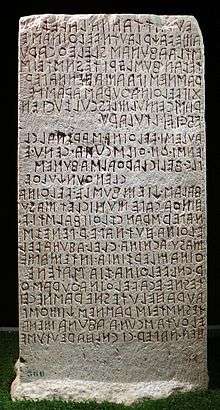
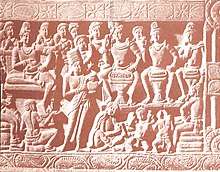
The Phoenician alphabet is simply the Proto-Canaanite alphabet as it was continued into the Iron Age (conventionally taken from a cut-off date of 1050 BC). This alphabet gave rise to the Aramaic and Greek alphabets. These in turn led to the writing systems used throughout regions ranging from Western Asia to Africa and Europe. For its part the Greek alphabet introduced for the first time explicit symbols for vowel sounds.[49] The Greek and Latin alphabets in the early centuries of the Common Era gave rise to several European scripts such as the Runes and the Gothic and Cyrillic alphabets while the Aramaic alphabet evolved into the Hebrew, Syriac and Arabic abjads and the South Arabian alphabet gave rise to the Ge'ez abugida, with other adaptations leading as far as Mongolian script. The Brahmic family of India is believed by some scholars to have derived from the Aramaic alphabet as well.[50]
Writing in the Greco-Roman civilizations
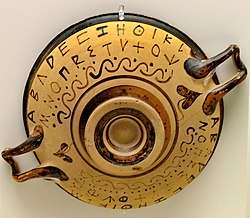
The history of the Greek alphabet started when the Greeks borrowed the Phoenician alphabet and adapted it to their own language.[51] The letters of the Greek alphabet are more or less the same as those of the Phoenician alphabet, and in modern times both alphabets are arranged in the same order.[51] The adapter(s) of the Phoenician system added three letters to the end of the series, called the "supplementals". Several varieties of the Greek alphabet developed. One, known as Western Greek or Chalcidian, was used west of Athens and in southern Italy. The other variation, known as Eastern Greek, was used in present-day Turkey and by the Athenians, and eventually the rest of the world that spoke Greek adopted this variation. After first writing right to left, like the Phoenicians, the Greeks eventually chose to write from left to right.
Greek is in turn the source for all the modern scripts of Europe. The most widespread descendant of Greek is the Latin script, named for the Latins, a central Italian people who came to dominate Europe with the rise of Rome. The Romans learned writing in about the 5th century BC from the Etruscan civilization, who used one of a number of Italic scripts derived from the western Greeks. Due to the cultural dominance of the Roman state, the other Italic scripts have not survived in any great quantity, and the Etruscan language is mostly lost.
Writing during the Middle Ages
With the collapse of the Roman authority in Western Europe, the literary development became largely confined to the Eastern Roman Empire and the Persian Empire. Latin, never one of the primary literary languages, rapidly declined in importance (except within the Church of Rome). The primary literary languages were Greek and Persian, though other languages such as Syriac and Coptic were important too.
The rise of Islam in the 7th century led to the rapid rise of Arabic as a major literary language in the region. Arabic and Persian quickly began to overshadow Greek's role as a language of scholarship. Arabic script was adopted as the primary script of the Persian language and the Turkish language. This script also heavily influenced the development of the cursive scripts of Greek, the Slavic languages, Latin, and other languages. The Arabic language also served to spread the Hindu–Arabic numeral system throughout Europe. By the beginning of the second millennium the city of Cordoba in modern Spain, had become one of the foremost intellectual centers of the world and contained the world's largest library at the time.[52] Its position as a crossroads between the Islamic and Western Christian worlds helped fuel intellectual development and written communication between both cultures.
Renaissance and the modern era
By the 14th century a rebirth, or renaissance, had emerged in Western Europe, leading to a temporary revival of the importance of Greek, and a slow revival of Latin as a significant literary language. A similar though smaller emergence occurred in Eastern Europe, especially in Russia. At the same time Arabic and Persian began a slow decline in importance as the Islamic Golden Age ended. The revival of literary development in Western Europe led to many innovations in the Latin alphabet and the diversification of the alphabet to codify the phonologies of the various languages.
The nature of writing has been constantly evolving, particularly due to the development of new technologies over the centuries. The pen, the printing press, the computer and the mobile phone are all technological developments which have altered what is written, and the medium through which the written word is produced. Particularly with the advent of digital technologies, namely the computer and the mobile phone, characters can be formed by the press of a button, rather than making a physical motion with the hand.
The nature of the written word has recently evolved to include an informal, colloquial written style, in which an everyday conversation can occur through writing rather than speaking. Written communication can also be delivered with minimal time delay (e-mail, SMS), and in some cases, with an imperceptible time delay (instant messaging). Writing is a preservable means of communication.
Writing materials
There is no very definite statement as to the material which was in most common use for the purposes of writing at the start of the early writing systems.[53] In all ages it has been customary to engrave on stone or metal, or other durable material, with the view of securing the permanency of the record; and accordingly, in the very commencement of the national history of Israel, it is read of the two tables of the law written in stone, and of a subsequent writing of the law on stone. In the latter case there is this peculiarity, that plaster (sic, lime or gypsum) was used along with stone, a combination of materials which is illustrated by comparison of the practice of the Egyptian engravers, who, having first carefully smoothed the stone, filled up the faulty places with gypsum or cement, in order to obtain a perfectly uniform surface on which to execute their engravings.[53] Metals, such as stamped coins, are mentioned as a material of writing; they include lead,[54] brass, and gold. To the engraving of gems there is reference also, such as with seals or signets.[53]
The common materials of writing were the tablet and the roll, the former probably having a Chaldean origin, the latter an Egyptian. The tablets of the Chaldeans are among the most remarkable of their remains. There are small pieces of clay, somewhat rudely shaped into a form resembling a pillow, and thickly inscribed with cuneiform characters.[55] Similar use has been seen in hollow cylinders, or prisms of six or eight sides, formed of fine terra cotta, sometimes glazed, on which the characters were traced with a small stylus, in some specimens so minutely as to be capable of decipherment only with the aid of a magnifying-glass.[53]
In Egypt the principal writing material was of quite a different sort. Wooden tablets are found pictured on the monuments; but the material which was in common use, even from very ancient times, was the papyrus, having recorded use as far back as 3,000 B.C.E.[56] This reed, found chiefly in Lower Egypt, had various economic means for writing, the pith was taken out, and divided by a pointed instrument into the thin pieces of which it is composed; it was then flattened by pressure, and the strips glued together, other strips being placed at right angles to them, so that a roll of any length might be manufactured. Writing seems to have become more widespread with the invention of papyrus in Egypt. That this material was in use in Egypt from a very early period is evidenced by still existing papyrus of the earliest Theban dynasties.[57] As the papyrus, being in great demand, and exported to all parts of the world, became very costly, other materials were often used instead of it, among which is mentioned leather, a few leather mills of an early period having been found in the tombs.[53] Parchment, using sheepskins left after the wool was removed for cloth, was sometimes cheaper than papyrus, which had to be imported outside Egypt. With the invention of wood-pulp paper, the cost of writing material began a steady decline. Wood-pulp paper is still used today, and in recent times efforts have been made in order to improve bond strength of fibers. Two main areas of examination in this regard have been "dry strength of paper" and "wet web strength".[58] The former involves examination of the physical properties of the paper itself, while the latter involves using additives to improve strength.
See also
- Main
- Phonetics, Palaeography, logograms, Brahmi, Devanagari, logographic, Vinča signs, Asemic writing
- General
- Alphabet, Palaeography, Inscriptions, Book, Manuscript, Shorthand, Latin alphabet, writing system, Braille, ogham, Indus script, Mixtec, uncials, Zapotec, Aurignacian, Chinese characters (Kanji, Hanja), Ugarit, Katakana, Hiragana, Acheulean, Ethnoarchaeology, Hoabinhian, Gravettian, Oldowan, Uruk, Etruscan, Cretan hieroglyphs, Nabataean, Luwian, Olmec, Busra, Tamil, Kannada, Grakliani Hill
- Other
- History of numbers, History of art (Ancient art), Oral literature, History of developmental dyslexia, Protoscholastic writing
Citations
- Peter T. Daniels, "The Study of Writing Systems", in The World's Writing Systems, ed. Bright and Daniels, p.3
- Empires of the Plain: Henry Rawlinson and the Lost Languages of Babylon, New York, St. Martin's Press (2003) ISBN 0-312-33002-2
- Olson, David R.; Torrance, Nancy (16 February 2009). The Cambridge Handbook of Literacy. Cambridge University Press. ISBN 9780521862202.
- More recent examples of this include Pahawh Hmong and the Cherokee syllabary
- Peter T. Daniels, "The First Civilizations", in The World's Writing Systems, ed. Bright and Daniels, p.24
- Regulski, Ilona (2 May 2016). "The Origins and Early Development of Writing in Egypt". doi:10.1093/oxfordhb/9780199935413.013.61. Cite journal requires
|journal=(help) - Wengrow, David. "The Invention of Writing in Egypt", in Before the Pyramids: Origin of Egyptian Civilization, Oriental Institute, University of Chicago, 2011, pp. 99-103.
- James Legge, D.D., translator, "The Shoo King, or the Book of Historical Documents, Volume III, Part I, page 12]. Early Chinese Writing", in The World's Writing Systems, ed. Bright and Daniels, p.191
- Brian M. Fagan, Charlotte Beck, ed. (1996). The Oxford Companion to Archaeology. Oxford University Press. p. 762. ISBN 978-0-19-507618-9.
- J. Baines (2004), "The earliest Egyptian writing: Development, context, purpose", in The First Writing. Script Invention as History and Process (Cambridge, England: Cambridge University Press), 150–189;
- G. Dreyer (1998), Umm el-Qaab I. Das prädynastische Königsgrab U-j und seine frühen Schriftzeugnisse (Mainz, Germany: Philip von Zabern).
- Woods, Christopher. "Visible language: the earliest writing systems." Visible Language: Inventions of Writing in the Ancient Middle East and Beyond. The Oriental Institute of the University of Chicago, Chicago, 2010, pp. 15-25.
- David N. Keightley, Noel Barnard. The Origins of Chinese civilization Page 415-416
- Sex and Eroticism in Mesopotamian Literature. By Dr Gwendolyn Leick. Pg 3.
- Walker, .C. (1989). Reading The Past Cuneiform. British Museum. pp. 7-9.
- "Image gallery: tablet / cast". British Museum.
- Fischer, Steven R., author. (March 2018). A history of reading. ISBN 9781789140682. OCLC 1101969075.CS1 maint: multiple names: authors list (link)
- "Beginning in the pottery-phase of the Neolithic, clay tokens are widely attested as a system of counting and identifying specific amounts of specified livestock or commodities. The tokens, enclosed in clay envelopes after being impressed on their rounded surface, were gradually replaced by impressions on flat or plano-convex tablets, and these in turn by more or less conventionalized pictures of the tokens incised on the clay with a reed stylus. That final step completed the transition to full writing, and with it the consequent ability to record contemporary events for posterity" W. Hallo; W. Simpson (1971). The Ancient Near East. New York: Harcourt, Brace, Jovanovich. p. 25.
- Daniels, Peter T. (1996). The World's Writing Systems. Oxford University Press. p. 45. ISBN 9780195079937.
- Boudreau, Vincent (2004). The First Writing: Script Invention as History and Process. Cambridge University Press. p. 71. ISBN 9780521838610.
- Shotwell, James Thomson. An Introduction to the History of History. Records of civilization, sources and studies. New York: Columbia University Press, 1922.
- Smail, Daniel Lord. On Deep History and the Brain. An Ahmanson foundation book in the humanities. Berkeley: University of California Press, 2008.
- Bricker, Victoria Reifler, and Patricia A. Andrews. Epigraphy. Supplement to the Handbook of Middle American Indians, v. 5. Austin: University of Texas Press, 1992.
- Barraclough, Geoffrey; Stone, Norman (1989). The Times Atlas of World History. Hammond Incorporated. p. 53. ISBN 9780723003045.
- Senner, Wayne M. (1991). The Origins of Writing. University of Nebraska Press. p. 77. ISBN 9780803291676.
- Haarmann, Harald: "Geschichte der Schrift", C.H. Beck, 2002, ISBN 3-406-47998-7, p. 20
- Salami, Minna (2020). "Chapter 2: Of Liberation". Sensuous Knowledge: A Black Feminist Approach For Everyone. Amistad. ISBN 9780062877062.
- Helen R. Pilcher 'Earliest handwriting found? Chinese relics hint at Neolithic rituals', Nature (30 April 2003), doi:10.1038/news030428-7 "Symbols carved into tortoise shells more than 8,000 years ago [...] unearthed at a mass-burial site at Jiahu in the Henan Province of western China". Li, X., Harbottle, G., Zhang, J. & Wang, C. 'The earliest writing? Sign use in the seventh millennium BC at Jiahu, Henan Province, China'. Antiquity, 77, 31 - 44, (2003).
- "Archaeologists Rewrite History". China Daily. 12 June 2003.CS1 maint: ref=harv (link)
- Houston, Stephen D. (2004). The First Writing: Script Invention as History and Process. Cambridge University Press. pp. 245–6. ISBN 978-0-521-83861-0.
- Haarmann 2010, 10: 5300 - 3200 BC.
- "Meroitic Writing System". Library.cornell.edu. 4 April 2004. Retrieved 31 January 2010.
- Scarre, Chris; Fagan, Brian M. (2016). Ancient Civilizations. Routledge. p. 106. ISBN 9781317296089.
- "The seal impressions, from various tombs, date even further back, to 3400 B.C. These dates challenge the commonly held belief that early logographs, pictographic symbols representing a specific place, object, or quantity, first evolved into more complex phonetic symbols in Mesopotamia." Mitchell, Larkin. "Earliest Egyptian Glyphs". Archaeology. Archaeological Institute of America. Retrieved 29 February 2012.
- Conference, William Foxwell Albright Centennial (1996). The Study of the Ancient Near East in the Twenty-first Century: The William Foxwell Albright Centennial Conference. Eisenbrauns. p. –24–25. ISBN 9780931464966.
- Geoffrey Sampson (1 January 1990). Writing Systems: A Linguistic Introduction. Stanford University Press. pp. 78–. ISBN 978-0-8047-1756-4. Retrieved 31 October 2011.
- Geoffrey W. Bromiley (June 1995). The international standard Bible encyclopedia. Wm. B. Eerdmans Publishing. pp. 1150–. ISBN 978-0-8028-3784-4. Retrieved 31 October 2011.
- Iorwerth Eiddon Stephen Edwards, et al., The Cambridge Ancient History (3d ed. 1970) pp. 43–44.
- Robert E. Krebs; Carolyn A. Krebs (December 2003). Groundbreaking scientific experiments, inventions, and discoveries of the ancient world. Greenwood Publishing Group. pp. 91–. ISBN 978-0-313-31342-4. Retrieved 31 October 2011.
- Simson Najovits, Egypt, Trunk of the Tree: A Modern Survey of an Ancient Land, Algora Publishing, 2004, pp. 55–56.
- Baines, J. (2007). Visual and Written Culture in Ancient Egypt. Oxford. pp. 118.
- Whitehouse, David (1999) 'Earliest writing' found BBC
- Robert Bagley (2004). "Anyang writing and the origin of the Chinese writing system". In Houston, Stephen (ed.). The First Writing: Script Invention as History and Process. Cambridge University Press. p. 190. ISBN 9780521838610. Retrieved 3 April 2019.
- William G. Boltz (1999). "Language and Writing". In Loewe, Michael; Shaughnessy, Edward L. (eds.). The Cambridge History of Ancient China: From the Origins of Civilization to 221 BC. Cambridge University Press. p. 108. ISBN 9780521470308. Retrieved 3 April 2019.
- Olivier 1986, pp. 377f.
- "Writing May Be Oldest in Western Hemisphere". The New York Times. 15 September 2006. Retrieved 30 March 2008.
A stone slab bearing 3,000-year-old writing previously unknown to scholars has been found in the Mexican state of Veracruz, and archaeologists say it is an example of the oldest script ever discovered in the Western Hemisphere.
- "'Oldest' New World writing found". BBC. 14 September 2006. Retrieved 30 March 2008.
Ancient civilisations in Mexico developed a writing system as early as 900 BC, new evidence suggests.
- "Oldest Writing in the New World". Science. Retrieved 30 March 2008.
A block with a hitherto unknown system of writing has been found in the Olmec heartland of Veracruz, Mexico. Stylistic and other dating of the block places it in the early first millennium before the common era, the oldest writing in the New World, with features that firmly assign this pivotal development to the Olmec civilization of Mesoamerica.
- Millard 1986, p. 396
- Salomon, Richard (1996). "Brahmi and Kharoshthi". The World's Writing Systems. Oxford University Press. ISBN 978-0-19-507993-7.
- McCarter, P. Kyle. "The Early Diffusion of the Alphabet", The Biblical Archaeologist 37, No. 3 (Sep., 1974): 54-68. page 62.
- Bury, J.B. The Cambridge Medieval History volumes 1-5. p. 1215.
- McClintock, J., & Strong, J. (1885). Cyclopedia of Biblical, theological, and ecclesiastical literature: Supplement. New York: Harper. Pages 990–997.
- though whether to writing on lead, or filling up the hollow of the letters with lead, is not certain.
- These documents have been in general enveloped, after they were baked, in a cover of moist clay, upon which their contents have been again inscribed, so as to present externally a duplicate of the writing within; and the tablet in its cover has then been baked afresh. The same material was largely used by the Assyrians, and many of their clay tablets still remain. They are of various sizes, ranging from nine inches long by six and a half wide, to an inch and a half by an inch wide, and even less. Some thousands of these have been recovered; many are historical, some linguistic, some geographical, some astronomical.
- Gascolgne, Arthur Bamber. "HISTORY OF WRITING MATERIALS". Retrieved 18 February 2019.
- Mark, Joshua J. "Egyptian Papyrus". Ancient History Encyclopedia.
- Lindström, Tom (Summer 2005). "On the nature of joint strength in paper-A review of dry and wet strength resins used in paper manufacturing". 13th Fundamental Research Symposium. 1: 457–562 – via Researchgate.
References
- Millard, A. R. (1986). "The Infancy of the Alphabet". World Archaeology. 17 (3): 390–398. doi:10.1080/00438243.1986.9979978.CS1 maint: ref=harv (link)
- Olivier, J.-P. (1986). "Cretan Writing in the Second Millennium B.C". World Archaeology. 17 (3): 377–389. doi:10.1080/00438243.1986.9979977.CS1 maint: ref=harv (link)
- Norman, Jerry (1988). Chinese. Cambridge University Press. ISBN 0-521-29653-6.CS1 maint: ref=harv (link)
- Lambert, J.L.F. (2014-2017). Termcraft: The emergence of terminology science from the Vinčans and Sumerians to Aristotle. Lulu Press. ISBN 978-1-7751129-2-1
Further reading
- 21st century sources
- The Idea of Writing: Writing Across Borders. Edited by Alex de Voogt, Joachim Friedrich Quack. BRILL, 9 Dec 2011.
- Powell, Barry B. 2009. Writing: Theory and History of the Technology of Civilization, Oxford: Blackwell. ISBN 978-1-4051-6256-2
- Steven R. Fischer A History of Writing, Reaktion Books 2005 CN136481
- Hoffman, Joel M. 2004. In the Beginning: A Short History of the Hebrew Language. New York University Press. Chapter 3.
- Jean-Jacques Glassner. The Invention of Cuneiform: Writing in Sumer. JHU Press, 2003. ISBN 0801873894
- Late 20th century sources
- Andrew Robinson, The Story of Writing. Thames & Hudson 1995 (second edition: 1999). ISBN 0-500-28156-4
- Hans J. Nissen, P. Damerow, R. Englund, Archaic Bookkeeping, University of Chicago Press, 1993, ISBN 0-500-01665-8
- Denise Schmandt-Besserat, Before Writing, Vol. I: From Counting to Cuneiform. University of Texas Press, 1992. ISBN 0292707835
- Denise Schmandt-Besserat, HomePage, How Writing Came About, University of Texas Press, 1992, ISBN 0-292-77704-3.
- Saggs, H., 1991. Civilization Before Greece and Rome. Yale University Press. Chapter 4.
- Jack Goody, The Logic of Writing and the Organization of Society. Cambridge University Press, 1986
- Earlier 20th century sources
- Otto Neugebauer, Abraham Joseph Sachs, Albrecht Götze. Mathematical Cuneiform Texts. Pub. jointly by the American Oriental Society and the American Schools of Oriental Research, 1945.
- Smith, William Anton. The Reading Process. New York: The Macmillan company, 1922.
- Chisholm, Hugh. Encyclopædia Britannica. A Dictionary of Arts, Sciences, Literature and General Information. Cambridge, Eng: University Press, 1911. "Writing".
- Clodd, Edward. The Story of the Alphabet. Library of useful stories.
External links
- Cuneiform
- cdli:wiki: Assyriological tools for specialists in cuneiform studies
- General
- History of Writing. historian.net
- Alphabet & protoalphabet the manifest of astrologic doctrine?
- The New Post-Literate
- Denise Schmandt-Besserat HomePage
- Children of the Code: A Brief History of Writing – Online Video
- Broadcasts
- Cracking the Maya Code. NOVA, Public Broadcasting Service. (Timeline (flash))
- BBC on tortoise shells discovered in China
- Fragments of pottery discovered in modern Pakistan
- Egyptian hieroglyphs c. 3000 BC
